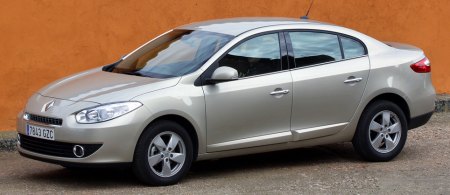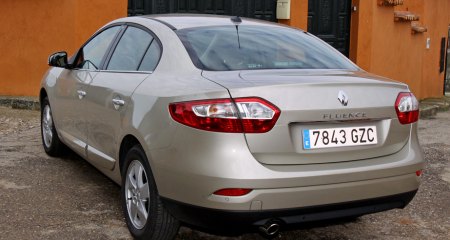Published
on 7
Apr 2012
|
All rights reserved.
|
|
|
Renault used to offer a
booted version for its Megane I and II. It was especially popular in
developing countries. Entering the third generation Megane, the
strategy was reshuffled. Now the Megane is built in hatchback forms (3
or 5-door) only, targeting primarily at its home market Western Europe.
At the same time, a sedan derivative is produced primarily for the
consumption of developing countries, most notably South America,
Eastern Europe and Turkey. This is Fluence.
The Fluence is actually a stretched and restyled version of Megane III.
Despite of a new fascia and headlights, it looks close to the Megane
from the nose up to the B-pillar. Thereafter it differs. The wheelbase
is stretched by 60 mm to 2702 mm in order to provide more rear seat
space. A long boot is introduced to accommodate 530 liters of luggage.
All these are enclosed within a sleek body. It should better fulfill
the new task as a company car or a graceful mid-size sedan.

Inside, the relationship with Megane is even more obvious as you can
see the same dashboard. We have no complaints about the Megane's
interior, so you should be pleased with its materials and build
quality. The rear seat affords excellent legroom, although 6-footers
may find headroom at premium due to the sloping roofline. On the roll,
you will find the sound-proofing is up to the job.
While European motorists see all-independent suspensions a must for
mid-size cars, buyers in developing countries are not so demanding.
They accept the torsion-beam axle on Fluence and its comfort-biased
suspension setup. Its combination of large ground clearance and long
travel suspension deals well with the poor roads commonly found in
developing countries. Inevitably, the car rolls heavily in corners and
shows a great deal of nose dive under braking. Turn-in is
sluggish, while the electrical power steering is light and lifeless.
Other controls are equally feather weight. There is not much fun to
talk about driving this car.

Buyers in developing countries are also less demanding for powertrains
as long as they are cheap to buy and repair. As a result, the Fluence
employs old generation of Renault engines, including the 110 hp
1.6-liter 16V and 140 hp 2.0-liter 16V. We haven't seen them for a long
time. Frankly, it is like seeing a good old friend coming back. There
is nothing too wrong with their power delivery, although the new
generation small turbocharged engines are quieter, more flexible and
frugal. The 110 hp 1.5dCi turbo diesel is the only up-to-date engine
available to the Fluence. Once it overcomes the rattling startup and
rough idle, it delivers superior refinement and passing ability than
the 1.6 petrol. Having said that, all Fluences are slow.
Although the Fluence is also available for sale in most European
countries, I suppose it is more a statement of "we offer a full range
of products" rather than a meaningful seller. Its vision is still
focused at the rest of the world. In fact, the rest of the world is so
big that Renault is not ashamed to call it a "world car". Production of
the car is equally global. It is built at Turkey, Argentina and South
Korea (by Renault Samsung under the name SM3).
|
Verdict:   |
Published
on 7
Apr 2012
|
All rights reserved.
|
|
Fluence Z.E.
|
|
Renault-Nissan boss Carlos
Ghosn is gambling big on electric cars. In the past five years, the
group invested €4 billion on its EV programs. Most people would think
of Nissan Leaf, which is arguably the world's first mass production EV.
However, Renault is going to take the limelight soon with the launch of
4 EVs in a row, i.e. Kangoo ZE, Fluence ZE, Twizy and Zoe. The Kangoo
van comes first to the market, but to me the passenger car Fluence ZE
is more significant since it will let us see how well EVs compete with
conventional or hybrid cars in private sector.
We would prefer to see the first Renault EV as a clean-sheet model like
what Nissan did. However, there is rationale to derive it from Fluence:
it keeps development and production cost down, enabling the car to be
more competitive against conventional cars. This is what current EVs,
including Leaf, has yet to achieve. You might ask why choose Fluence
instead of other production Renaults. Yes, we are not happy with this
decision either, but it seems that the Fluence is most suitable to the
job, considering its adequate size and the availability of a big boot
for installation of battery. Moreover, the Fluence is already a "world
car", so it guarantees the new EV to be easily marketable in a variety
of countries.
Cosmetically, the ZE, which stands for Zero Emission, differs from the
regular Fluence in a few areas,
some are modified for functions and some are for looks only.
Unfortunately, most of these changes actually work against aesthetic.
The most influential of which is the lengthening of its boot by 130 mm
to make space for the battery, which sits vertically behind the cabin.
This makes the tail unnecessarily long and leads to a funny
proportion. Another eyesore is the black rectangular fascia, apparently
introduced to distinguish from the regular car, but it only manages to
show a poor taste. As the EV demands less cooling, its lower bumper
intake is largely sealed by a new panel, which looks like aftermarket
treatment. To reduce drag, the Fluence' substantial ride height has
been lowered considerably while diffusers have been added to the rear
overhang. New taillight clusters and blue tint at head and tail lights
look cool, if a bit gimmicky. The design was obviously
signed off before the arrival of Laurens Van den Acker.
Inside, the Fluence ZE shares much the same interior with regular
Fluence. If you look for a fancy design and sophisticated features like
Leaf or Volt, you will be disappointed. This car feels by all means
normal. It even starts with a key! skipping the trendy start button.
The 3-gauge instrument pod looks conventional, too, although one of the
gauges is converted to display charging/discharging status while
another shows battery level and range. Well, at least you will get used
to it easily. TomTom infotainment system is made standard as it helps
to navigate to the nearest charging station. It will even warn you if
you set the destination beyond its expected range. The rest of the
cabin is just like other Fluences. Space is plenty for front and rear
passengers.
Predictably, the big battery behind the cabin hampers luggage space,
leaving only 317 liters and a short, irregular-shaped loading area. It
also loses the split rear seats.
Now let's turn to the engineering aspect. The ZE has its electric
drivetrain, including an AC synchronize motor, inverter, power control
module and their cooling sytem, installed in the engine compartment
like conventional cars. The combined unit even looks like a
four-cylinder engine! The motor produces a modest 95 horsepower at 3000
rpm, while 167 pound-foot of torque is available right from the
beginning. At the back, the space-saving torsion-beam rear axle fits
perfectly with the vertically stacked lithium-ion battery pack. The
latter is huge, weighing 280 kg and has a capacity of 22 kWh.
The battery pack is designed to be compatible with the Quick Drop
battery switch system of Better Place. In Israel, Denmark and Australia
where Better Place stations are present, you can have the dry battery
replaced with a fully charged one in 3 minutes, just like refilling at
gas station. The robotic system of the station recognizes the car,
unload its battery pack from the bottom of the car, select the right
type of new battery and reinstall to the car automatically. The
depleted battery will be recharged overnight at the station, taking
advantage of the lower electricity rate for non-peak hours. It will
then be used on another car. As you can see, buyers of the Fluence ZE
do not own the batteries. The battery is leased for a monthly fee like
your mobile phone plan. This enable the electric car to lower its price
dramatically. In the UK, for example, the Fluence ZE is sold at
£23,000 (before the government grant of £5,000 for EVs),
much cheaper than Nissan Leaf (£31,000 before grant) and
Chevrolet Volt / Vauxhall Ampera (£34,000 before grant). This
makes it the first truly affordable EV ! The battery lease fee is not
expensive either, costing £81 per month for a 3-year plan. That
is cheaper than your fuel bill.
Admittedly, the UK plan does not cover battery switch as it is not
available in the country. Buyers have to recharge their ZE at home,
which takes 6-8 hours, or other public facility with 3-phase quick
charger, which takes half an hour to reach 80 percent full. Taking
electricity bill into account, the running cost is still reasonable.
The problem is not financial, but usability. Despite of a claimed range
of 185 km (115 miles) according to NEDC standard, in reality it can
easily drop below 80 km (50 miles) even though you are driving in
normal manner, especially in cold weather or traffic jam. This makes it
simply unusable if you live outside urban area.
The driving dynamics also fails to match conventional cars or hybrids.
Weighing 1605 kg – that's a massive 380 kg more than the regular
Fluence – and offers only 95 hp for your disposal, the ZE is slow.
Admittedly, its instant torque gives it stronger acceleration than the
1.6-liter Fluence at low speed, but after 50 mph its torque drops off
quickly. It takes 13 long seconds to hit 60 mph. Top speed is limited
to 84 mph to avoid abusing the battery.
The handling is equally disappointing, although not so much if you are
familiar with Fluence. There are lots of pitch and roll due to the
unremarkable chassis and the weight of the battery, which is positioned
high, unlike other EVs which place them close to the floorpan or in
transmission tunnel. The Goodyear energy saving tires are not very
grippy. Like the regular Fluence, the superlight steering delivers no
feel, although brake pedal feel is not bad for an EV. Ride still biases
towards the comfort side, but it is not as absorbent as the regular car
because the rear axle is stiffened to take on the heavy battery. It
occasionally crashes on big bumps.
That said, if you do not pursue a fun driving character and good
styling, the ZE's quietness, smoothness and easy-going manner may suit
you. Just make sure you don't need to travel long distance.
|
Verdict:   |
|